Novel Preservation Methods for Inorganic Arsenic Speciation in Model and Natural Water Samples by Stripping Voltammetric Method
Abstract
1. Introduction
2. Materials and Methods
2.1. Reagents
2.2. Preparation of Standard Solutions
2.3. Model Sample Solutions Preparation
2.4. Ground Water Sample Collection and Sample Treatment
2.5. Preparation of Supporting Electrolyte Solution
2.6. Instrumentation
2.7. Activation of the scTRACE Gold Electrode
2.8. Determination of As(III)
2.9. Determination of As(total)
3. Results and Discussion
3.1. Model Solution Experiments—As(III/V) Stability in Preserved and Unpreserved Model Solutions
3.2. Preservation Studies of As(III/V) Stability in Natural Water Samples
4. Conclusions
Author Contributions
Funding
Institutional Review Board Statement
Informed Consent Statement
Data Availability Statement
Acknowledgments
Conflicts of Interest
References
- Ardini, F.; Dan, G.; Grotti, M. Arsenic speciation analysis of environmental samples. J. Anal. At. Spectrom. 2020, 35, 215–237. [Google Scholar] [CrossRef]
- Sodhi, K.K.; Kumar, M.; Agrawal, P.K.; Singh, D.K. Perspectives on arsenic toxicity, carcinogenicity and its systemic remediation strategies. Environ. Technol. Innov. 2019, 16, 100462. [Google Scholar] [CrossRef]
- Yu, X.; Cui, W.; Wang, Q.; Guo, Y.; Deng, T. Speciation analysis of arsenic in samples containing high concentrations of chloride by LC-HG-AFS. Anal. Bioanal. Chem. 2019, 411, 7251–7260. [Google Scholar]
- Lukojko, E.; Talik, E.; Gagor, A.; Sitko, R. Highly selective determination of ultratrace inorganic arsenic species using novel functionalized miniaturized membranes. Anal. Chim. Acta 2018, 1008, 57–65. [Google Scholar] [CrossRef]
- Cassone, G.; Chillé, D.; Foti, C.; Giuffré, O.; Ponterio, R.C.; Sponer, J.; Saija, F. Stability of hydrolytic arsenic species in aqueous solutions: As3+ vs. As5+. Phys. Chem. Chem. Phys. 2018, 20, 23272–23280. [Google Scholar] [CrossRef]
- World Health Organization. Arsenic—World Health Organization. Fact Sheets. 2018. Available online: https://www.who.int/news-room/fact-sheets/detail/arsenic (accessed on 3 March 2019).
- Hung, D.Q.; Nekrassova, O.; Compton, R.G. Analytical methods for inorganic arsenic in water: A review. Talanta 2004, 64, 269–277. [Google Scholar] [CrossRef] [PubMed]
- Hall, G.E.M.; Pelchat, J.C.; Gauthier, G.J. Stability of inorganic arsenic (III) and arsenic (V) in water samples. J. Anal. At. Spectrom. 1999, 14, 205–213. [Google Scholar] [CrossRef]
- Tallman, D.E.; Shaikh, A.U. Redox stability of inorganic arsenic (III) and arsenic (V) in aqueous solution. Anal. Chem. 1980, 52, 196–199. [Google Scholar] [CrossRef]
- Rassler, M.; Michalke, B.; Schramel, P.; Schuste-Hostede, S.; Kettrup, A. Speciation of inorganic arsenic and selenium in contaminated ground water samples-distribution and long-term stability of species. Int. J. Environ. Anal. Chem. 1998, 72, 195–203. [Google Scholar] [CrossRef]
- Bednar, A.J.; Garbarino, J.R.; Ranville, J.F.; Wildeman, T.R. Preserving the distribution of inorganic arsenic species in groundwater and acid mine drainage samples. Environ. Sci. Technol. 2002, 36, 2213–2218. [Google Scholar] [CrossRef] [PubMed]
- Oliveira, V.; Sarmiento, A.M.; Gomez-Ariza, J.L.; Nieto, J.M.; Sanchez-Rodas, D. New preservation method for inorganic arsenic speciation in acid mine drainage samples. Talanta 2006, 69, 1182–1189. [Google Scholar] [CrossRef] [PubMed]
- Pillay, L.; Kindness, A. A preliminary investigation into the stability of inorganic arsenic species in laboratory solutions simulating sediment pore water. S. Afr. J. Chem. 2016, 69, 9–14. [Google Scholar] [CrossRef][Green Version]
- Williams, M. Arsenic in mine waters: An international study. Environ. Geol. 2001, 49, 267–278. [Google Scholar] [CrossRef]
- Welch, A.H.; Westjohn, D.B.; Helsel, D.R.; Wanty, R.B. Arsenic in ground water of the United States: Occurrence and geochemistry. Ground Water 2000, 38, 589–604. [Google Scholar] [CrossRef]
- Daus, B.; Weiss, H.; Mattusch, J.; Wennrich, R. Preservation of arsenic species in water samples using phosphoric acid—Limitations and long-term stability. Talanta 2006, 69, 430–434. [Google Scholar] [CrossRef] [PubMed]
- Apelblat, A. Citric Acid; Springer International Publishing: Cham, Switzerland, 2014; Volume 1. [Google Scholar]
- Saritha, A.; Raju, B.; Ramachary, M.; Raghavaiah, P.; Hussain, K.A. Synthesis, crystal structure and characterization of chiral, three-dimensional anhydrous potassium tris(oxalato)ferrate (III). Physica B Condens. Matter 2012, 407, 4208–4213. [Google Scholar] [CrossRef]
- Kassaian, J.M. Ullmann’s Encyclopedia of Industrial Chemistry; Wiley-VCH: Weinheim, Germany, 2002; Volume 35, p. 671. [Google Scholar]
- Smedley, P.L.; Kinniburgh, D.G. A review of the source, behaviour and distribution of arsenic in natural waters. Appl. Geochem. 2002, 17, 517–568. [Google Scholar] [CrossRef]
- McCleskey, R.B.; Nordstrom, D.K.; Maest, A.S. Preservation of water samples for arsenic(III/V) determinations: An evaluation of the literature and new analytical results. Appl. Geochem. 2004, 19, 995–1009. [Google Scholar] [CrossRef]
- Döker, S.; Yılmaz, M. Speciation of arsenic in spring, well, and tap water by high-performance liquid chromatography–inductively coupled plasma-mass spectrometry. Anal. Lett. 2018, 51, 254–264. [Google Scholar] [CrossRef]
- Lee, H.G.; Kwon, J.Y.; Chung, D.S. Sensitive arsenic speciation by capillary electrophoresis using UV absorbance detection with on-line sample preconcentration techniques. Talanta 2018, 181, 366–372. [Google Scholar]
- Dominiquez-Alvarez, J. Capillary electrophoresis coupled to electrospray mass spectrometry for the determination of organic and inorganic arsenic compounds in water samples. Talanta 2020, 212, 120803. [Google Scholar] [CrossRef] [PubMed]
- Yang, M.; Liamtsau, V.; Fan, C.; Sylvers, K.L.; McGoron, A.J.; Liu, G.; Fu, F.; Cai, Y. Arsenic speciation on silver nanofilms by surface-enhanced Raman spectroscopy. Anal. Chem. 2019, 91, 8280–8288. [Google Scholar] [CrossRef] [PubMed]
- Wei, C.; Liu, J. A new hydride generation system applied in determination of arsenic species with ion chromatography–hydride generation-atomic fluorescence spectrometry (IC–HG-AFS). Talanta 2007, 73, 540–545. [Google Scholar] [CrossRef]
- Dai, X.; Nekrassova, O.; Hyde, M.E.; Compton, R.G. Anodic stripping voltammetry of arsenic (III) using gold nanoparticle-modified electrodes. Anal. Chem. 2004, 76, 5924–5929. [Google Scholar] [CrossRef] [PubMed]
- Jagner, D.; Årén, K. Derivative potentiometric stripping analysis with a thin film of mercury on a glassy carbon electrode. Anal. Chim. Acta 1978, 100, 375–388. [Google Scholar] [CrossRef]
- Ostapczuk, P.; Valenta, P.; Rützel, H.; Nürnberg, H.W. Application of differential pulse anodic stripping voltammetry to the determination of heavy metals in environmental samples. Sci. Total. Environ. 1987, 60, 1–16. [Google Scholar] [CrossRef]
- Chadima, P.; Švancara, I.; Pihlarb, B.; Vytřasa, K. Gold-Plated Carbon Paste Electrodes for Anodic Stripping Determination of Arsenic. Collect. Czech. Chem. Commun. 2000, 65, 1035–1046. [Google Scholar] [CrossRef]
- Salaün, P.; Planer-Friedrich, B.; van den Berg, C.M.G. Inorganic arsenic speciation in water and seawater by anodic stripping voltammetry with a gold microelectrode. Anal. Chim. Acta 2007, 585, 312–322. [Google Scholar] [CrossRef]
- Bednar, A.J.; Garbarino, J.R.; Burkhardt, M.R.; Ranville, J.F.; Wildeman, T.R. Field and laboratory arsenic speciation methods and their application to natural-water analysis. Water Res. 2004, 38, 355–364. [Google Scholar] [CrossRef]
- Cherry, J.A.; Shaikh, A.U.; Tallman, D.E.; Nicholson, R.V. Arsenic species as an indicator of redox conditions in groundwater. Dev. Water Sci. 1979, 12, 373–392. [Google Scholar]
- Anawar, H.M.; Akai, J.; Komaki, K.; Terao, H.; Yoshioka, T.; Ishizuka, T.; Safiullah, S.; Kato, K. Geochemical occurrence of arsenic in groundwater of Bangladesh: Sources and mobilization processes. J. Geochem. Explor. 2003, 77, 109–131. [Google Scholar] [CrossRef]
- Romić, Ž.; Habuda-Stanić, M.; Kalajdžić, B.; Kuleš, M. Arsenic distribution, concentration and speciation in groundwater of the Osijek area, eastern Croatia. Appl. Geochem. 2011, 26, 37–44. [Google Scholar] [CrossRef]
- Ujević, M.; Duić, Ž.; Casiot, C.; Sipos, L.; Santo, V.; Dadić, Ž.; Halamić, J. Occurrence and geochemistry of arsenic in the groundwater of Eastern Croatia. Appl. Geochem. 2010, 25, 1017–1029. [Google Scholar] [CrossRef]
- Herath, I.; Vithanage, M.; Bundschuh, J.; Maity, J.P.; Bhattacharya, P. Natural arsenic in global groundwaters: Distribution and geochemical triggers for mobilization. Curr. Pollut. Rep. 2016, 2, 68–89. [Google Scholar] [CrossRef]
- Emmett, M.T.; Khoe, G.H. Photochemical oxidation of arsenic by oxygen and iron in acidic solutions. Water Res. 2001, 35, 649–656. [Google Scholar] [CrossRef]
- Samanta, G.; Clifford, D.A. Preservation of inorganic arsenic species in groundwater. Environ. Sci. Technol. 2005, 39, 8877–8882. [Google Scholar] [CrossRef]
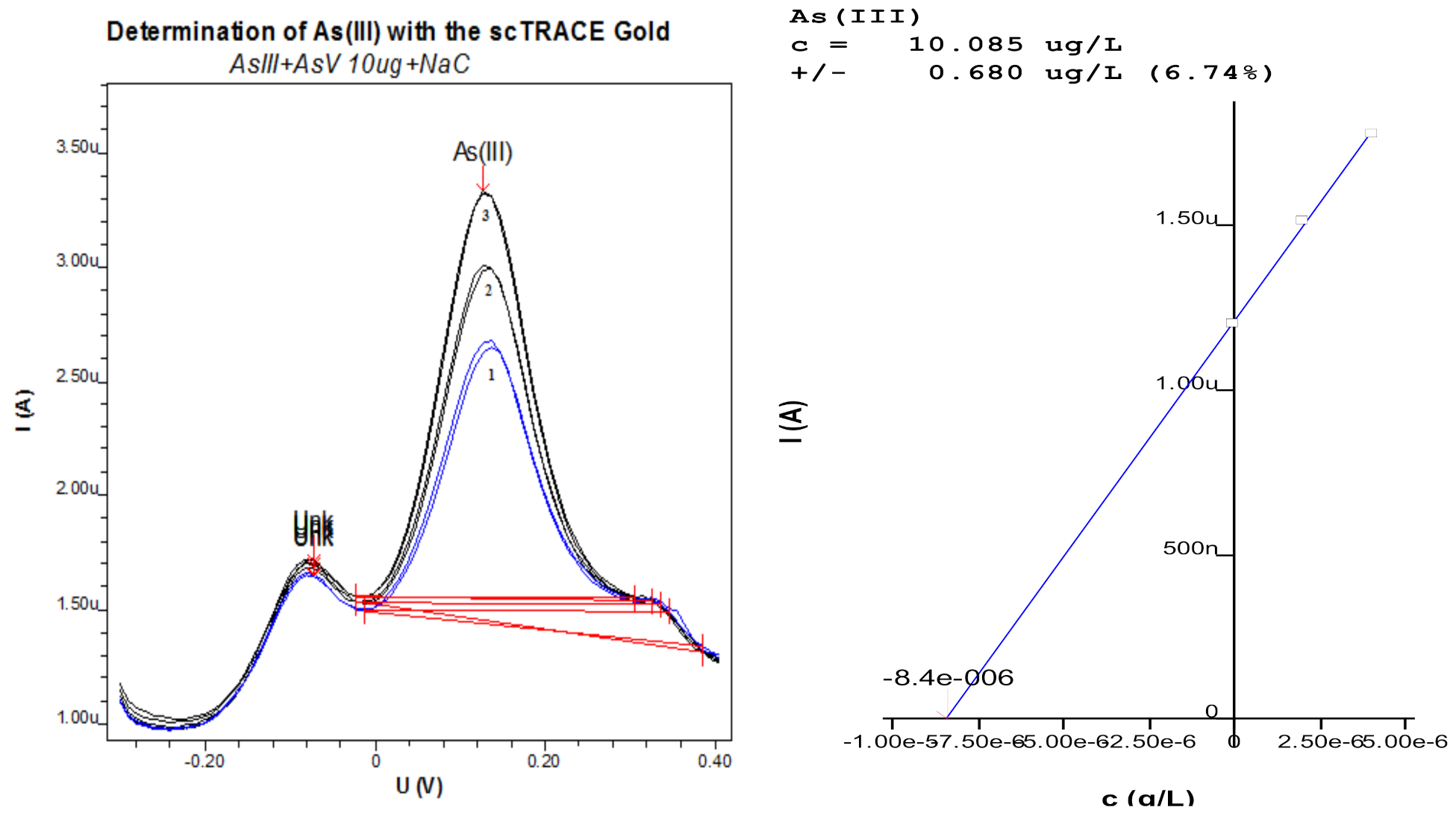
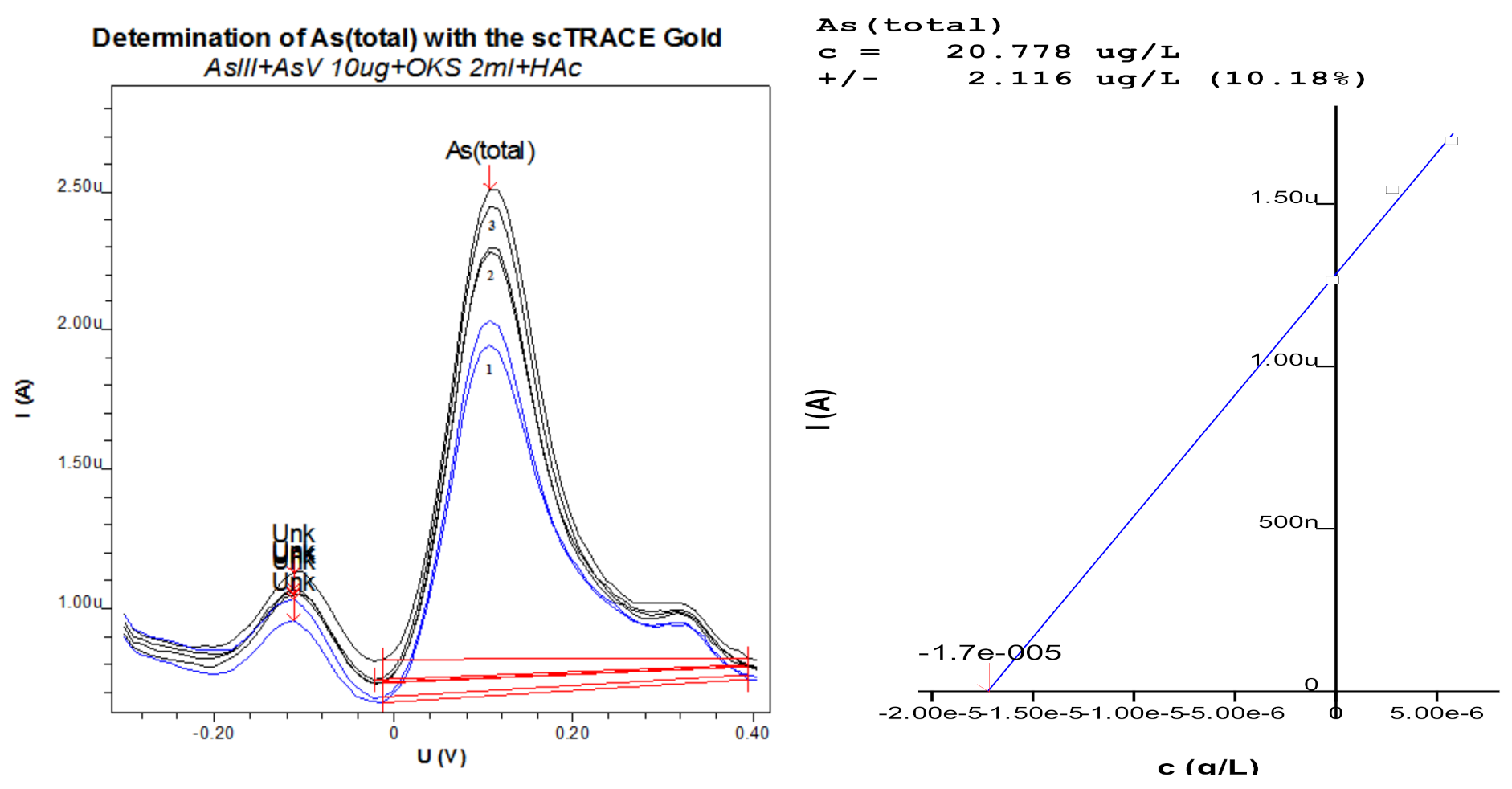
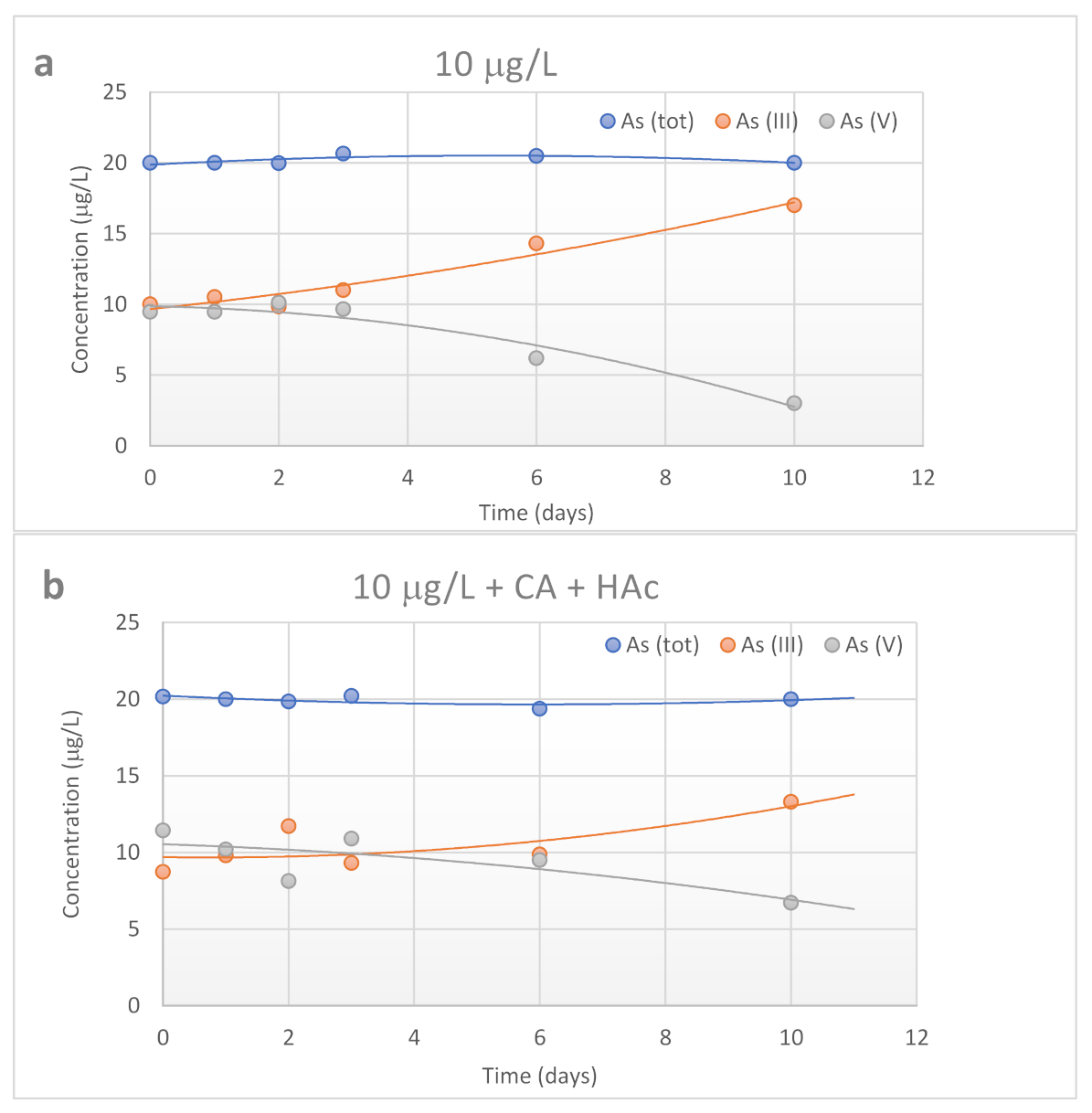


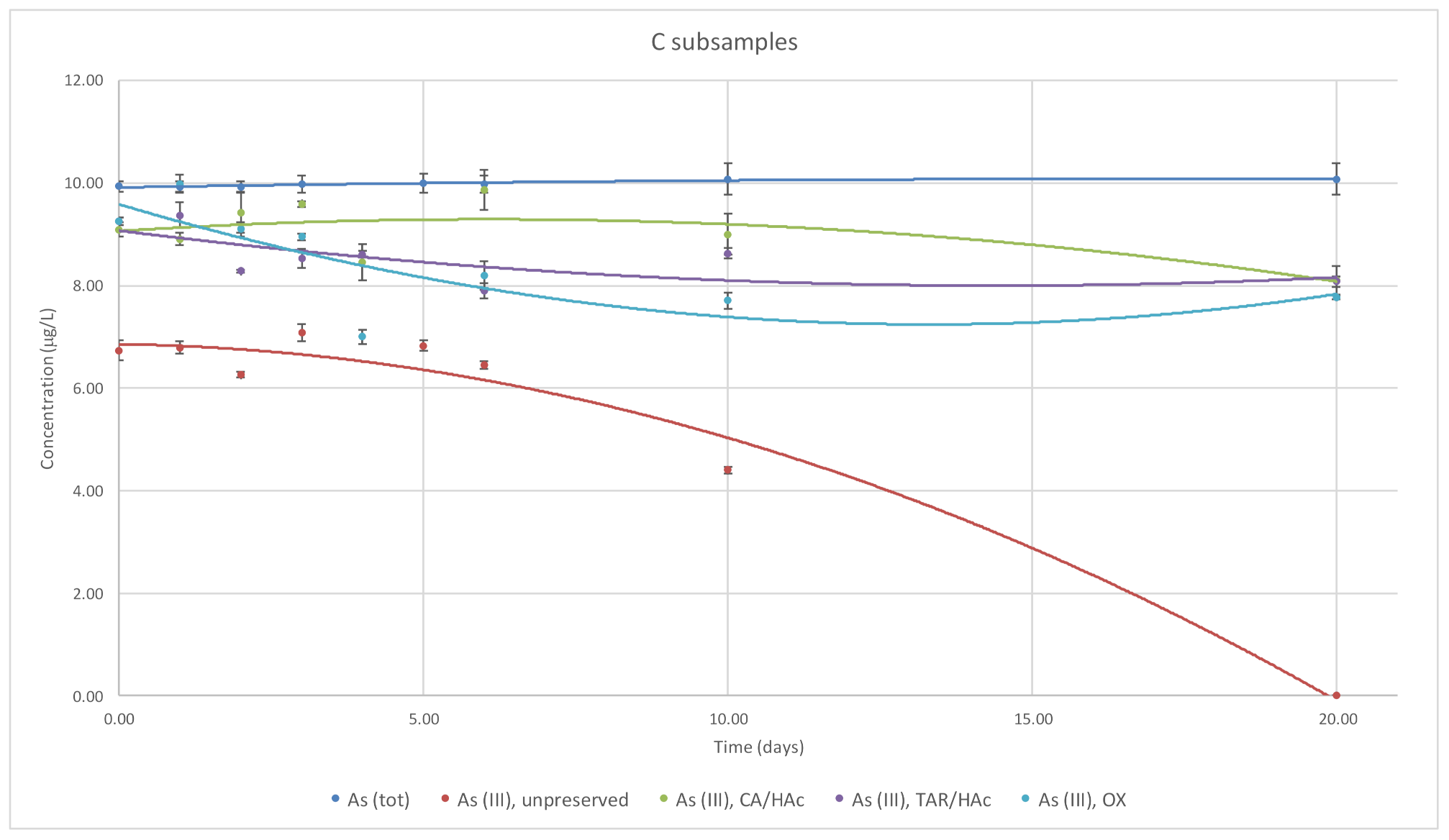
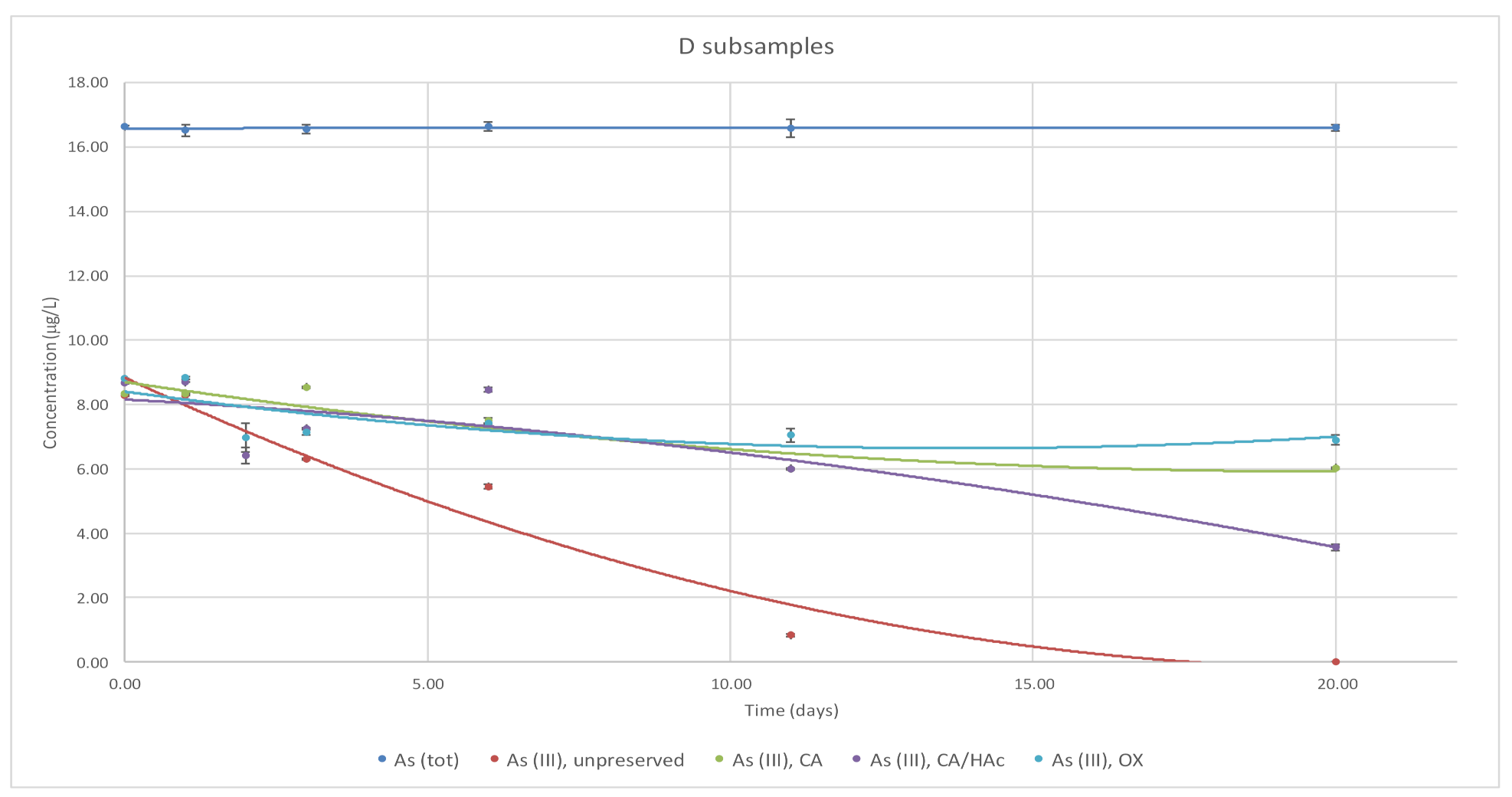
| Sample | Time after Sampling | ||||||
|---|---|---|---|---|---|---|---|
| 3 h | 24 h | 48 h | 3 days | 7 days | 9 days | 10 days | |
| 1: Unpreserved | |||||||
| As(III) | 10.01 | 10.91 | 9.85 | 11.00 | 14.30 | a | 17.01 |
| As(V) | 9.48 | 10.52 | 10.13 | 9.66 | 6.20 | a | 3.00 |
| 2: CA, c = 2 × 10−3 mol L−1 | |||||||
| As(III) | 9.84 | 9.11 | a | 9.14 | 10.14 | 18.10 | 16.50 |
| As(V) | 10.24 | 12.89 | a | 10.86 | 10.00 | 1.90 | 3.50 |
| 3: CA, c = 2 × 10−3 mol L−1 + HAc | |||||||
| As(III) | 8.74 | 9.81 | 11.70 | 9.31 | 9.87 | a | 13.30 |
| As(V) | 11.42 | 10.19 | 8.13 | 10.89 | 9.50 | a | 6.70 |
| 4: NaC, c = 2 × 10−3 mol L−1 | |||||||
| As(III) | 10.09 | 9.46 | 9.83 | 3.4 | 3.79 | a | a |
| As(V) | 8.92 | 10.55 | 9.67 | 20.40 | 23.41 | a | a |
| 5: NaC, c = 2 × 10−3 mol L−1 + HAc | |||||||
| As(III) | 9.75 | 9.46 | 8.40 | 9.71 | 9.57 | 9.90 | 5.50 |
| As(V) | 9.95 | 11.57 | 12.20 | 10.29 | 10.22 | 10.10 | 14.52 |
| 6: TAR, c = 2 × 10−3 mol L−1 | |||||||
| As(III) | 10.48 | 10.56 | a | 14.80 | 13.77 | a | 20.01 |
| As(V) | 7.62 | 8.16 | a | 5.80 | 6.33 | a | 0 |
| 7: TAR, c = 2 × 10−3 mol L−1 + HAc | |||||||
| As(III) | 11.00 | 10.55 | 9.76 | 10.15 | 9.91 | a | 12.90 |
| As(V) | 9.54 | 9.63 | 10.84 | 9.47 | 10.74 | a | 7.10 |
| 8: OX, c = 2 × 10−3 mol L−1 | |||||||
| As(III) | 10.30 | 10.15 | 10.60 | 10.10 | 10.40 | a | 11.08 |
| As(V) | 9.71 | 9.41 | 8.30 | 10.02 | 10.60 | a | 8.92 |
| 9: OX, c = 2 × 10−3 mol L−1 + HAc | |||||||
| As(III) | 10.06 | 9.60 | 6.75 | 6.87 | 7.40 | 6.05 | a |
| As(V) | 11.73 | 11.07 | 16.25 | 16.16 | 13.04 | 13.95 | a |
| 10: HAc | |||||||
| As(III) | 9.60 | 9.52 | 6.20 | a | 7.60 | a | 14.30 |
| As(V) | 10.55 | 10.48 | 14.75 | a | 12.43 | a | 6.70 |
| Sample | Place of Origin | As (tot)/μg L−1 | As (III)/μg L−1 | As (V)/μg L−1 | Fe/mg L−1 | pH |
|---|---|---|---|---|---|---|
| A | Osijek | 110.0 | 48.5 | 61.5 | 130.0 | 8.42 |
| B | Osijek | 164.8 | 118.0 | 46.8 | 88.3 | 8.02 |
| C | Zagreb | 9.86 | 8.5 | 1.36 | 10.5 | 8.32 |
| D | Zagreb | 16.62 | 8.46 | 8.16 | 10.15 | 8.24 |
| Sample | A | B | ||||
|---|---|---|---|---|---|---|
| Initial As(III) Concentration (μg L−1) | As(III) Concentration After 6 Days (μg L−1) | % Deviation | Initial As(III) Concentration (μg L−1) | As(III) Concentration After 6 Days (μg L−1) | % Deviation | |
| Unpreserved | 38.68 | 5.10 | 86.81 | 115.88 | 4.55 | 96.07 |
| CA | 50.00 | 46.20 | 7.60 | 118.73 | 100.90 | 15.02 |
| CA + HAc | 48.50 | 49.48 | 2.02 | 117.00 | 94.06 | 19.61 |
| NaC | 51.50 | 68.00 | 32.04 | 107.90 | 64.11 | 40.58 |
| NaC + HAc | 76.00 | 64.36 | 15.32 | 140.18 | 68.89 | 50.86 |
| TAR | 52.00 | 65.10 | 25.19 | 138.91 | 78.69 | 43.35 |
| TAR + HAc | 49.20 | 66.04 | 34.23 | 143.80 | 99.86 | 30.56 |
| OX | 62.12 | 19.02 | 69.38 | 106.15 | 32.80 | 69.10 |
| OX + HAc | 60.60 | 20.50 | 66.17 | 98.53 | 60.96 | 38.13 |
| HAc | 60.00 | 36.11 | 39.82 | 18.13 | 77.45 | 327.19 |
| Sample | C | D | ||||
|---|---|---|---|---|---|---|
| Initial As(III) Concentration (μg L−1) | As(III) Concentration After 6 Days (μg L−1) | % Deviation | Initial As(III) Concentration (μg L−1) | As(III) Concentration After 6 Days (μg L−1) | % Deviaton | |
| Unpreserved | 6.87 | 4.50 | 34.39 | 8.30 | 5.50 | 33.73 |
| CA | 9.00 | 4.80 | 46.67 | 8.35 | 7.43 | 11.02 |
| CA + HAc | 9.02 | 9.60 | 6.43 | 8.70 | 8.50 | 2.30 |
| NaC | 8.50 | 5.15 | 39.41 | 8.65 | 6.20 | 28.32 |
| NaC + HAc | 9.30 | 9.86 | 6.02 | 6.40 | 6.00 | 6.25 |
| TAR | 8.20 | 5.40 | 34.15 | 7.70 | 5.40 | 29.87 |
| TAR + HAc | 9.25 | 7.80 | 15.68 | 8.05 | 5.20 | 35.40 |
| OX | 9.20 | 8.40 | 8.70 | 8.80 | 7.41 | 15.80 |
| OX + HAc | 9.21 | 1.97 | 78.61 | 8.15 | 5.02 | 38.40 |
| HAc | 8.90 | 4.90 | 44.94 | 9.54 | 1.00 | 89.52 |
Publisher’s Note: MDPI stays neutral with regard to jurisdictional claims in published maps and institutional affiliations. |
© 2021 by the authors. Licensee MDPI, Basel, Switzerland. This article is an open access article distributed under the terms and conditions of the Creative Commons Attribution (CC BY) license (https://creativecommons.org/licenses/by/4.0/).
Share and Cite
Alispahić, A.; Krivohlavek, A.; Galić, N. Novel Preservation Methods for Inorganic Arsenic Speciation in Model and Natural Water Samples by Stripping Voltammetric Method. Appl. Sci. 2021, 11, 8811. https://doi.org/10.3390/app11198811
Alispahić A, Krivohlavek A, Galić N. Novel Preservation Methods for Inorganic Arsenic Speciation in Model and Natural Water Samples by Stripping Voltammetric Method. Applied Sciences. 2021; 11(19):8811. https://doi.org/10.3390/app11198811
Chicago/Turabian StyleAlispahić, Amra, Adela Krivohlavek, and Nives Galić. 2021. "Novel Preservation Methods for Inorganic Arsenic Speciation in Model and Natural Water Samples by Stripping Voltammetric Method" Applied Sciences 11, no. 19: 8811. https://doi.org/10.3390/app11198811
APA StyleAlispahić, A., Krivohlavek, A., & Galić, N. (2021). Novel Preservation Methods for Inorganic Arsenic Speciation in Model and Natural Water Samples by Stripping Voltammetric Method. Applied Sciences, 11(19), 8811. https://doi.org/10.3390/app11198811








